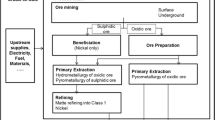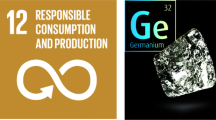Abstract
Goal and Background
Current Life Cycle Impact Assessment (LCIA) procedures have demonstrated certain limitations in the South African manufacturing industry. The aim of this paper is to propose new characterisation and normalisation factors for classified mined abiotic resource depletion categories in the South African context. These factors should reflect the importance of mined resources as they relate to region-specific resource depletion. The method can also be applied to determine global factors.
Methods
The reserve base (as in 2001) of the most commonly produced minerals in South Africa is used as basis to determine characterisation factors for a non-renewable mineral resources category. The average production of these minerals from 1991 to 2000 is compared to economically Demonstrated and Demonstrated Marginal Reserves (and not ultimate reserves) to obtain the characterisation factors in equivalence units, with platinum as the reference mineral. Similarly, for a non-renewable energy resources category, coal is used in South Africa as equivalent unit as it is the most important fossil fuel for the country. Crude oil and natural gas resources are currently obtained from reserves elsewhere in the world and characterisation factors are therefore determined using global resources and production levels. The normalisation factors are based on the total economic reserves of key South African minerals and world non-renewable energy resources respectively. A case study of the manufacturing of an exhaust system for a standard sedan is used to compare LCIA results for mined abiotic resource categories that are based on current LCIA factors and the new South African factors.
Results and Discussion
The South African LCIA procedure differs from current methods in that it shows the importance of other mined resources, i.e. iron ore and crude oil, relative to PGMs and coal for the manufacturing life cycle of the exhaust system. With respect to PGMs, the current characterisation factors are based on the concentrations of the metals in the ores and the ultimate reserves, which are erroneous with respect to the actual availability of the mineral resources and the depletion burden placed on these minerals is consequently too high.
Conclusions
The South African LCIA procedure for mined abiotic resources depletion shows the significance of choosing a method, which is inline with the current situation in the mining industry and its limitations.
Recommendations and Outlook
It is proposed to similarly investigate the impacts of the use of other natural resource groups. Water, specifically, must receive attention in the characterisation phase of LCIAs in South African LCAs.
Similar content being viewed by others
Author information
Authors and Affiliations
Corresponding authors
Rights and permissions
About this article
Cite this article
Strauss, K., Brent, A. & Hietkamp, S. Characterisation and Normalisation Factors for Life Cycle Impact Assessment Mined Abiotic Resources Categories in South Africa: The manufacturing of catalytic converter exhaust systems as a case study (10 pp). Int J Life Cycle Assessment 11, 162–171 (2006). https://doi.org/10.1065/lca2004.10.183
Received:
Accepted:
Published:
Issue Date:
DOI: https://doi.org/10.1065/lca2004.10.183




